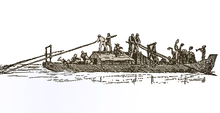One way ship
As disposable ship (English disposable ship ) was called a ship in the 19th century, the only large quantities to transport timber was built and in which even the hull basically belonged to the charge. The wood of the hull was also used for quick recycling, because the ship was carefully demolished and the wood was also sold.
history
Inland shipping
In earlier times, heavy loads such as stones and grain were mainly transported by ship. A disadvantage was the low loading capacity of the ships and the non-existent or only limited possibility of moving the ships upstream against the strong currents of the rivers. For this reason, one-way ships were often used, which drifted down into the valley with the flow of the rivers ( Nauffahrt ). The wood of these ships, which were often only roughly built, was reused in many ways and in full at the end of the journey. This is how the Lauertanne was used on the Upper and Middle Rhine . A Bohemian variant of the barge was built on the Vltava and was also mostly transported as a one-way ship with freight across the Elbe to the Märkische areas.
In the river navigation of the foothills of the Alps, the plateaus and zillen, including the Ulmer boxes , were used. Platten were intended for the transport of goods and were mostly sold like rafts after the descent at the destination as coveted construction and timber or for further use as a barge. They were covered in the stern area if valuable cargo was to be protected. The simple construction made it cheap as a one-way ship, the lack of a keel made it less sensitive to the shallows of the mountain rivers, which usually only periodically had enough water.
seafaring
In the 19th century, the United Kingdom 's import tax on timber from the New World was 275 percent of the value of the actual timber cargo on ships. The timber of the ship, which was transporting timber, was not affected by the high British import duties on oak and pine. The ships were built from roughly hewn squared timber, often assembled in two layers, and caulked only superficially, sometimes not at all . Many ships of this type were only partially seaworthy according to nautical rules and the crews were thrown together and only poorly trained or not at all. The more wood was built into the ship's hull, the higher the expected profit while avoiding customs duties. After arriving in British ports and unloading the cargo, the ships were laid up and carefully dismantled. The wood was used as construction timber, but also for shipbuilding. It happened that the wood of British ships had already crossed the Atlantic as a ship before the new British ship had even left a port on a maiden voyage. For many ships of the 19th century, the return trip from England to North America was in any case unprofitable due to the low cargo volume and unfavorable customs laws. A return voyage with a small cargo usually required the use of ballast stones to ensure the stability of the ship during the crossing. Field stones had no particular commercial value and loading and unloading was expensive and time consuming. After the British government reduced import duties on timber loads, this form of shipbuilding was discontinued. One of the largest one-way ships ever to be used was the Baron of Renfrew .
literature
- Wallace, Fredrick William: Wooden Ships and Iron Men . White Lion, London, 1973/1924.
- Williams, David M .: Bulk Carriers and Timber Imports: The British North American Trade and the Shipping Boom of 1824-5 . The Mariner's Mirror Vol. 54, London, 1968. pp. 373-382
- Wood, Charles: Ballast . John Clark, Glasgow, 1836.
- Jenny Sarrazin, André van Holk: Schopper and Zillen . An introduction to traditional wooden shipbuilding in the German Danube region. Kabel Verlag, Hamburg 1996, ISBN 3-8225-0334-7 .
- Karl Ebner: Floating and shipping on inland waters with special consideration of timber transports in Austria, Germany and Western Russia . Vienna and Leipzig 1912
- Ernst Neweklowsky: Shipping on the Danube and its tributaries . In: German Museum. Reports and treatises, Volume 26, Issue 3. 1952 OCLC 7620427
- Michael Sohn: Coffee boats . A bygone form of barge. Self-published by Sohn-Art, Hennigsdorf 2013, ISBN 978-3-00-041659-0 .
- Kurt Schaefer: Historic ships in Vienna . Neuer Wissenschaftlicher Verlag GmbH, 2002, ISBN 978-3-7083-0037-5 .
Web links
- Information about the ship Baron of Renfrew (English) accessed on February 4, 2015

